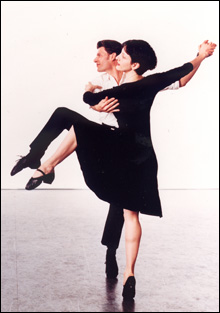
THE ARGUMENT: More challenging to the mind than to the body. |
Two of Boston’s major dance series wound up their 2006–2007 season last week with low-calorie desserts. The Celebrity Series offered the dance revue Palladium Nights by Ballet Hispánico and the Afro-Latin Jazz Orchestra; the Institute for Contemporary Art presented the Mark Morris Dance Group for six sold-out performances. CRASHarts will complete its dance calendar with Snappy Dance, at the Calderwood Pavilion, May 30 through June 10.
Mark Morris’s new work, Looky, begins in the dark. We hear a piano thumping out a polytonal three-hand rhythm. The lights gradually come up on a piano with the keys going up and down. No one occupies the bench where the musician should be, but a motionless man sits in a chair in another part of the stage. I guess, if you put any stock in dance titles, Morris is asking us to look at the music first. The anomaly on view couldn’t have been a recording, since the playerless piano was obviously doing the work. Mechanical pianola music seemed to be the answer, but the program informed us that composer Kyle Gann used a Disklavier, a high-tech version of the old piano-roll idea.

With a Disklavier, the music is digitized in the computer and rigged up to a retrofitted piano. The notes can be electronically programmed any way the composer dictates, or set up to go beyond anything previously imagined. Gann, the new-music critic for the Village Voice, is a composer in the freewheeling mode of American mavericks like Charles Ives, Henry Cowell, and Harry Partch. Conlon Nancarrow, another individualist, was the subject of a 1995 book-length study by Gann. The maniacally speeded-up and layered effects Nancarrow could get from the player piano became one strand of Gann’s fascinating score.
The dancers drift in, pointing and gazing intently at something up above them or inspecting a spot on the floor or staring at one another. They stroll from place to place, sit for a while in some chairs. They walk around, sit in different chairs. The music becomes a waltz with unpredictably changing tempos. Dancer Joe Bowie sprawls face down on the piano bench. It’s all beginning to look like an actors’ exercise, or a nod to Morris’s postmodern dance predecessors, who insisted on the intrinsic validity of ordinary movement as a subject of performance.
Some of the dancers begin to do a few ballet moves with mock histrionics. The others stand or sit around and watch them. We hear modern-jazz chord sequences with Nancarrow notes careering above them, and the dancers simulate a clichéd nightclub scene. Some of them dance a “floor show” while others mime drinking, conversation, looking, a slow-motion brawl. There’s more mock ballet and more spectatorship. Some of the onlookers seem to scribble notes into imaginary handheld notebooks.
They all become critics, then, exchanging roles as statues and gawking museumgoers. Finally, to a deranged ragtime tune, a kind of chorus line goes into action. While a row of dancers upstage look at them, two dancers sit in chairs at the edge of the stage and look straight out at the real audience.
I liked the way Morris snuck up on us with this comment on the incarnations of an audience, but I thought the dance aspects of the idea were awfully slight. Two of the other three dances on the program also seemed more challenging to the mind than to the body. The Argument, which premiered in Boston eight years ago, is set to folk-song-derived pieces for cello and piano by Robert Schumann. Three couples, in different temperaments, find themselves at odds, and we perceive their differences through gestures (he grabs her shoulders, she shrugs away . . . ), acting (furious looks), and movement patterns (a couple do a few steps in unison but immediately get out of phase).
Simple walking steps can lead to skipping, running, jumping, as the dancers absorb a rhythm from the music, and later in the piece the musicians send little whiffs of csárdás and waltz blowing across the movement. Often the music’s propulsive energy is transferred to precisely calibrated gestures.
The acting in Morris’s work never looks spontaneous because it’s so formally organized. His dance vocabulary always seems dependent on a concept or a musical trigger, but it often seems transparent, lacking in an emphasis of its own. In Candleflowerdance, six dancers form and re-form their grouping within the boundaries of a square laid out on the floor. I’ve retained almost no specifics of this dance, except for the dynamic dissonances of Stravinsky’s Serenade in A.
Grand Duo brought the program to an uproarious conclusion. Lou Harrison, another fabulously wacko American composer, was a friend of Morris’s, and his music has brought out the choreographer’s best. Grand Duo is a tribal rout for 14 dancers, who evolve from cryptic faux primitif posturing into a simulated battle between two teams that charge at each other and retreat without actually coming into contact. As the pianist (Steven Beck) punches out tone clusters with his fist, the dance ends in a galvanic, stomping ritualized frenzy that makes the audience laugh out loud through its cheers.